Lukasz Kaiser
Tony
OpenAI o1 System Card
Dec 21, 2024



Abstract:The o1 model series is trained with large-scale reinforcement learning to reason using chain of thought. These advanced reasoning capabilities provide new avenues for improving the safety and robustness of our models. In particular, our models can reason about our safety policies in context when responding to potentially unsafe prompts, through deliberative alignment. This leads to state-of-the-art performance on certain benchmarks for risks such as generating illicit advice, choosing stereotyped responses, and succumbing to known jailbreaks. Training models to incorporate a chain of thought before answering has the potential to unlock substantial benefits, while also increasing potential risks that stem from heightened intelligence. Our results underscore the need for building robust alignment methods, extensively stress-testing their efficacy, and maintaining meticulous risk management protocols. This report outlines the safety work carried out for the OpenAI o1 and OpenAI o1-mini models, including safety evaluations, external red teaming, and Preparedness Framework evaluations.
GPT-4o System Card
Oct 25, 2024Abstract:GPT-4o is an autoregressive omni model that accepts as input any combination of text, audio, image, and video, and generates any combination of text, audio, and image outputs. It's trained end-to-end across text, vision, and audio, meaning all inputs and outputs are processed by the same neural network. GPT-4o can respond to audio inputs in as little as 232 milliseconds, with an average of 320 milliseconds, which is similar to human response time in conversation. It matches GPT-4 Turbo performance on text in English and code, with significant improvement on text in non-English languages, while also being much faster and 50\% cheaper in the API. GPT-4o is especially better at vision and audio understanding compared to existing models. In line with our commitment to building AI safely and consistent with our voluntary commitments to the White House, we are sharing the GPT-4o System Card, which includes our Preparedness Framework evaluations. In this System Card, we provide a detailed look at GPT-4o's capabilities, limitations, and safety evaluations across multiple categories, focusing on speech-to-speech while also evaluating text and image capabilities, and measures we've implemented to ensure the model is safe and aligned. We also include third-party assessments on dangerous capabilities, as well as discussion of potential societal impacts of GPT-4o's text and vision capabilities.
Training Verifiers to Solve Math Word Problems
Nov 18, 2021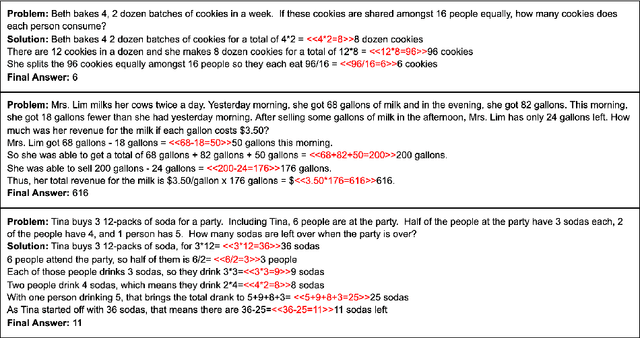
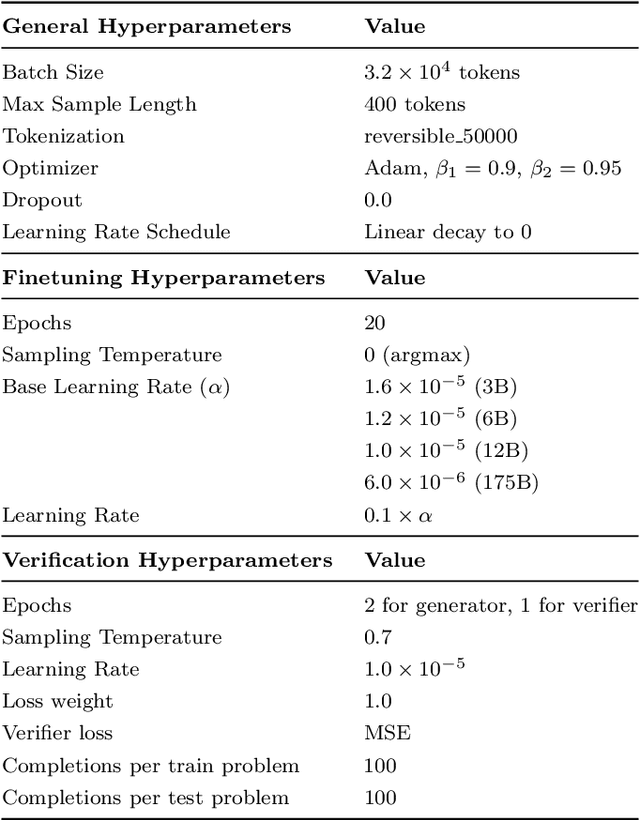
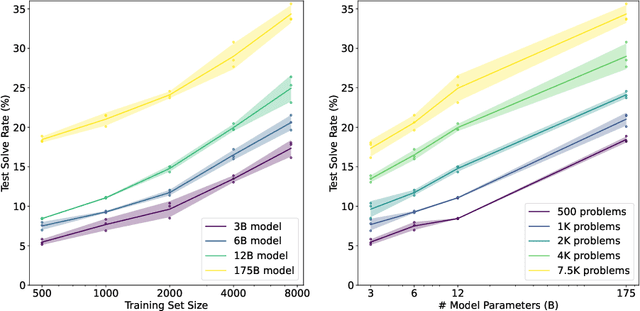
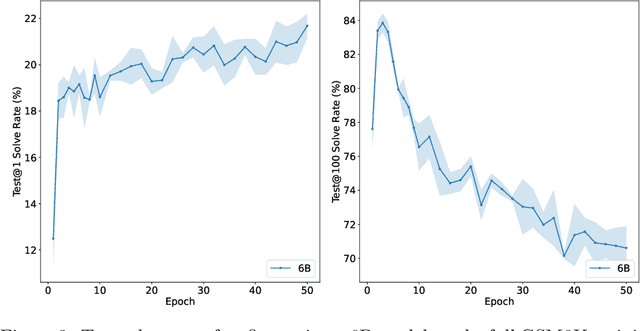
Abstract:State-of-the-art language models can match human performance on many tasks, but they still struggle to robustly perform multi-step mathematical reasoning. To diagnose the failures of current models and support research, we introduce GSM8K, a dataset of 8.5K high quality linguistically diverse grade school math word problems. We find that even the largest transformer models fail to achieve high test performance, despite the conceptual simplicity of this problem distribution. To increase performance, we propose training verifiers to judge the correctness of model completions. At test time, we generate many candidate solutions and select the one ranked highest by the verifier. We demonstrate that verification significantly improves performance on GSM8K, and we provide strong empirical evidence that verification scales more effectively with increased data than a finetuning baseline.
Evaluating Large Language Models Trained on Code
Jul 14, 2021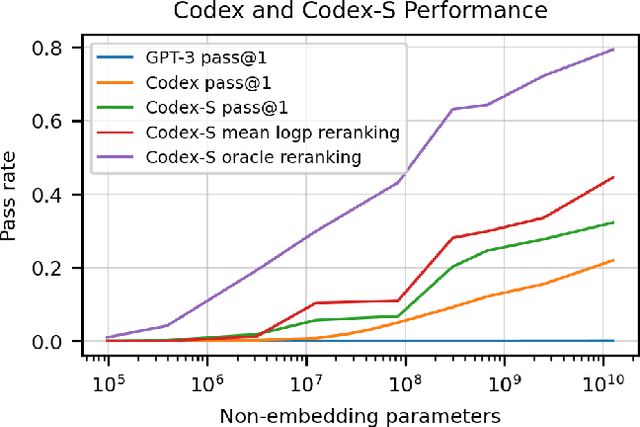
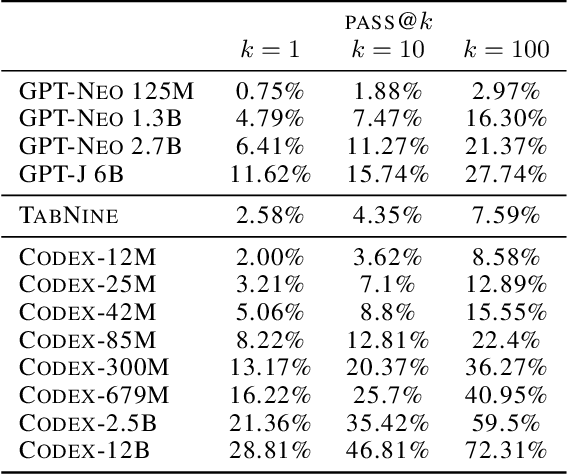
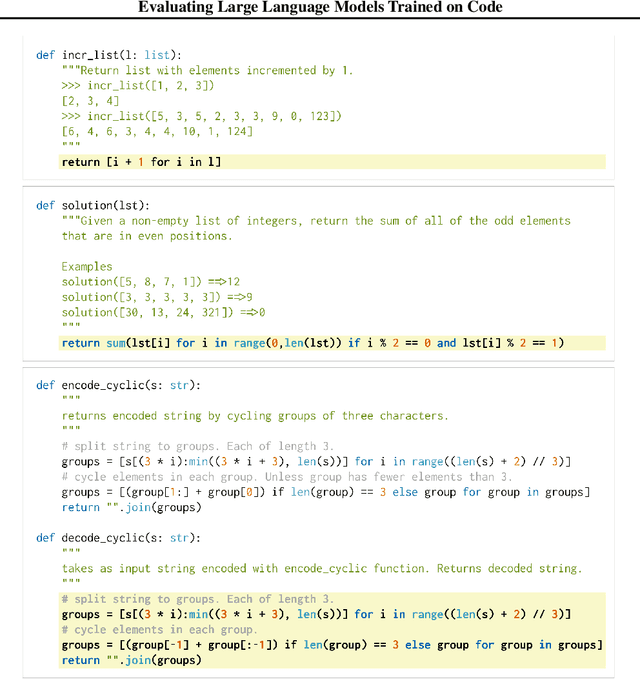

Abstract:We introduce Codex, a GPT language model fine-tuned on publicly available code from GitHub, and study its Python code-writing capabilities. A distinct production version of Codex powers GitHub Copilot. On HumanEval, a new evaluation set we release to measure functional correctness for synthesizing programs from docstrings, our model solves 28.8% of the problems, while GPT-3 solves 0% and GPT-J solves 11.4%. Furthermore, we find that repeated sampling from the model is a surprisingly effective strategy for producing working solutions to difficult prompts. Using this method, we solve 70.2% of our problems with 100 samples per problem. Careful investigation of our model reveals its limitations, including difficulty with docstrings describing long chains of operations and with binding operations to variables. Finally, we discuss the potential broader impacts of deploying powerful code generation technologies, covering safety, security, and economics.
Rethinking Attention with Performers
Sep 30, 2020
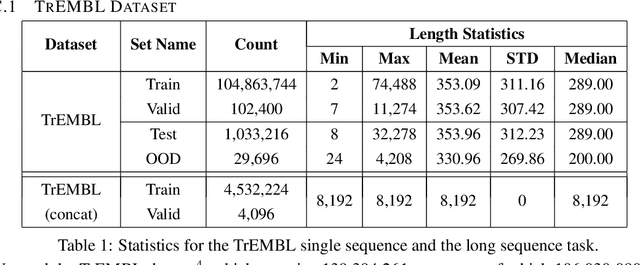

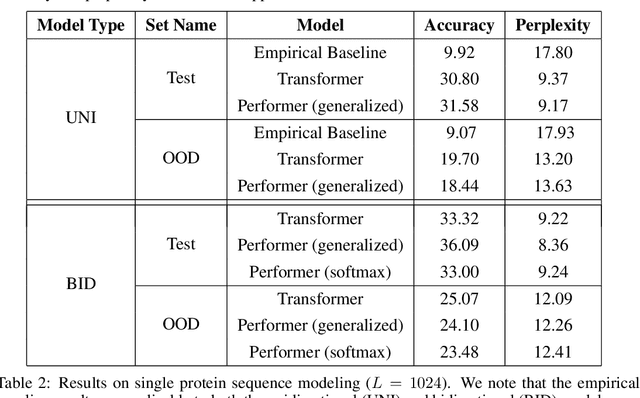
Abstract:We introduce Performers, Transformer architectures which can estimate regular (softmax) full-rank-attention Transformers with provable accuracy, but using only linear (as opposed to quadratic) space and time complexity, without relying on any priors such as sparsity or low-rankness. To approximate softmax attention-kernels, Performers use a novel Fast Attention Via positive Orthogonal Random features approach (FAVOR+), which may be of independent interest for scalable kernel methods. FAVOR+ can be also used to efficiently model kernelizable attention mechanisms beyond softmax. This representational power is crucial to accurately compare softmax with other kernels for the first time on large-scale tasks, beyond the reach of regular Transformers, and investigate optimal attention-kernels. Performers are linear architectures fully compatible with regular Transformers and with strong theoretical guarantees: unbiased or nearly-unbiased estimation of the attention matrix, uniform convergence and low estimation variance. We tested Performers on a rich set of tasks stretching from pixel-prediction through text models to protein sequence modeling. We demonstrate competitive results with other examined efficient sparse and dense attention methods, showcasing effectiveness of the novel attention-learning paradigm leveraged by Performers.
Parallel Scheduled Sampling
Jun 11, 2019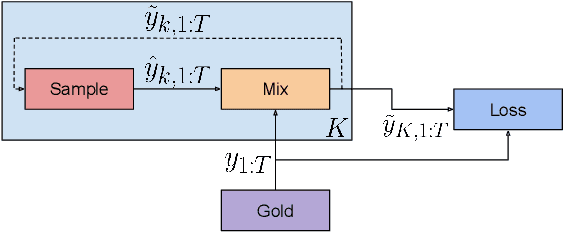
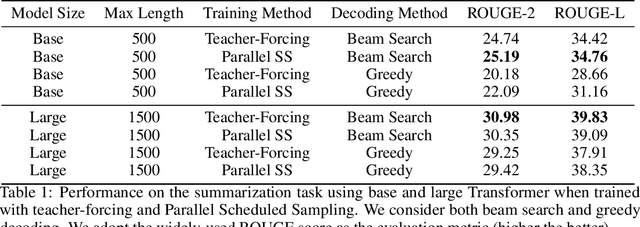
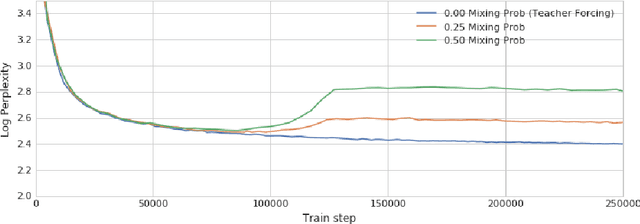
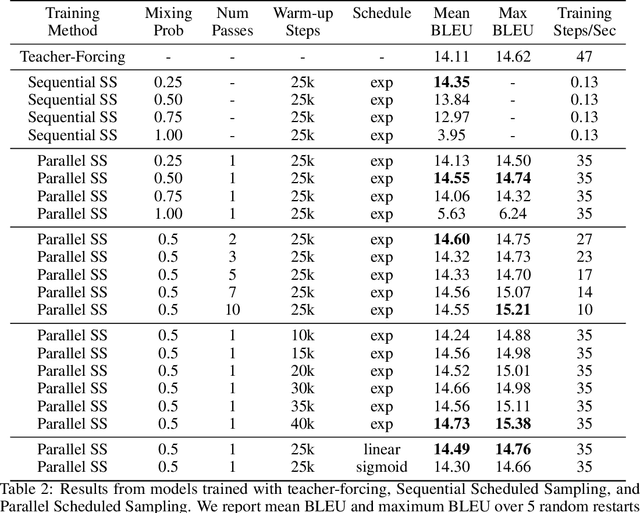
Abstract:Auto-regressive models are widely used in sequence generation problems. The output sequence is typically generated in a predetermined order, one discrete unit (pixel or word or character) at a time. The models are trained by teacher-forcing where ground-truth history is fed to the model as input, which at test time is replaced by the model prediction. Scheduled Sampling aims to mitigate this discrepancy between train and test time by randomly replacing some discrete units in the history with the model's prediction. While teacher-forced training works well with ML accelerators as the computation can be parallelized across time, Scheduled Sampling involves undesirable sequential processing. In this paper, we introduce a simple technique to parallelize Scheduled Sampling across time. We find that in most cases our technique leads to better empirical performance on summarization and dialog generation tasks compared to teacher-forced training. Further, we discuss the effects of different hyper-parameters associated with Scheduled Sampling on the model performance.
Sample Efficient Text Summarization Using a Single Pre-Trained Transformer
May 21, 2019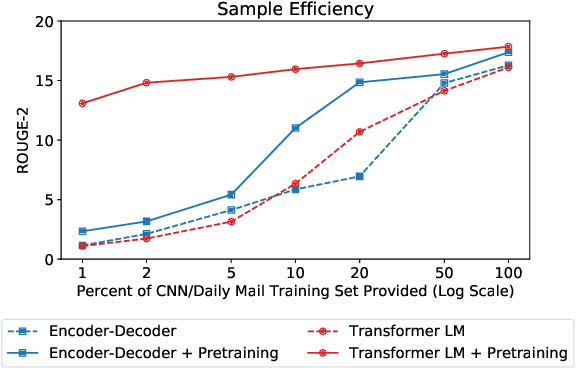
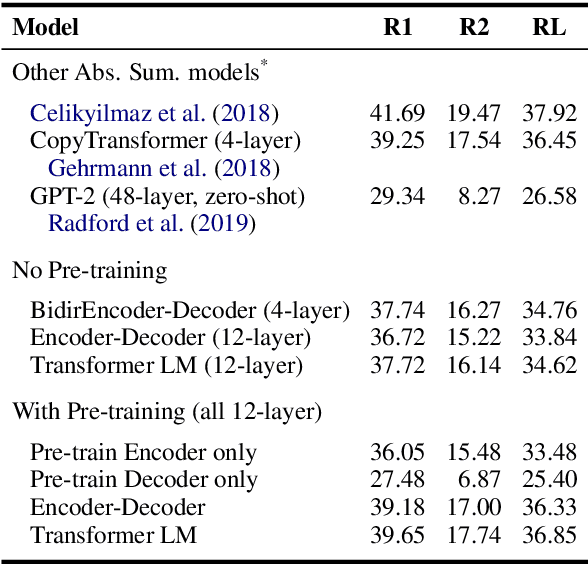

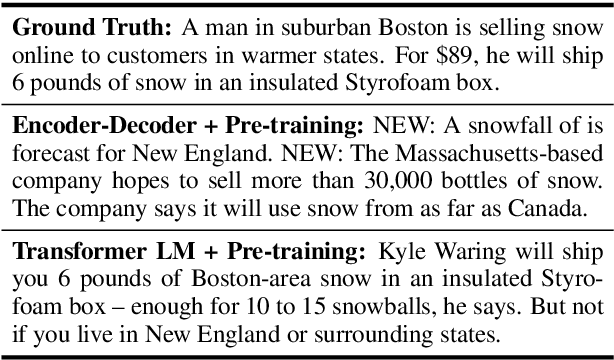
Abstract:Language model (LM) pre-training has resulted in impressive performance and sample efficiency on a variety of language understanding tasks. However, it remains unclear how to best use pre-trained LMs for generation tasks such as abstractive summarization, particularly to enhance sample efficiency. In these sequence-to-sequence settings, prior work has experimented with loading pre-trained weights into the encoder and/or decoder networks, but used non-pre-trained encoder-decoder attention weights. We instead use a pre-trained decoder-only network, where the same Transformer LM both encodes the source and generates the summary. This ensures that all parameters in the network, including those governing attention over source states, have been pre-trained before the fine-tuning step. Experiments on the CNN/Daily Mail dataset show that our pre-trained Transformer LM substantially improves over pre-trained Transformer encoder-decoder networks in limited-data settings. For instance, it achieves 13.1 ROUGE-2 using only 1% of the training data (~3000 examples), while pre-trained encoder-decoder models score 2.3 ROUGE-2.
Model-Based Reinforcement Learning for Atari
Mar 05, 2019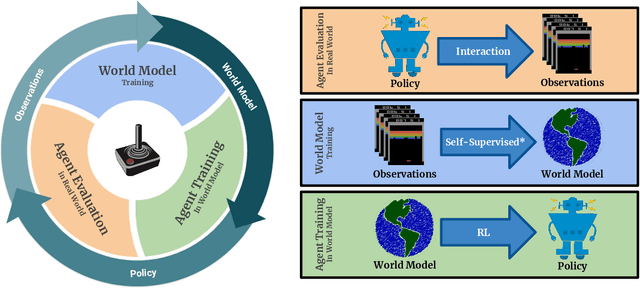
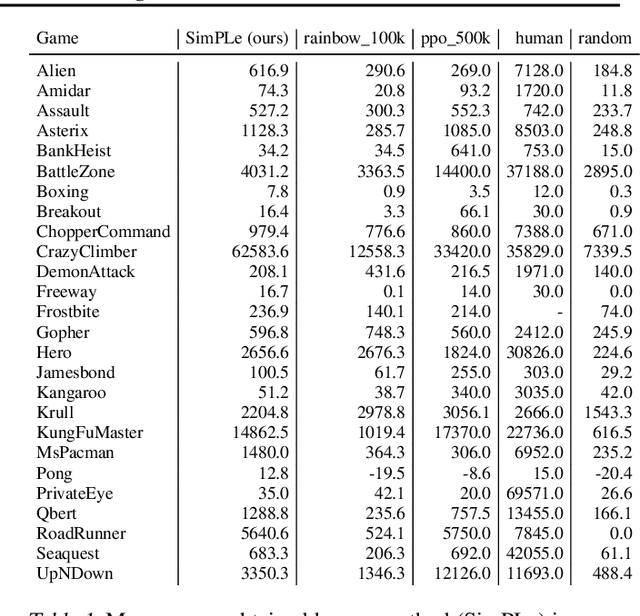
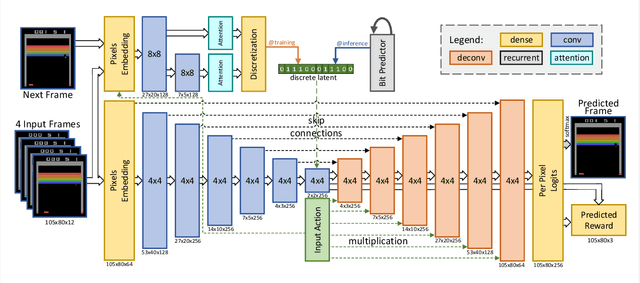
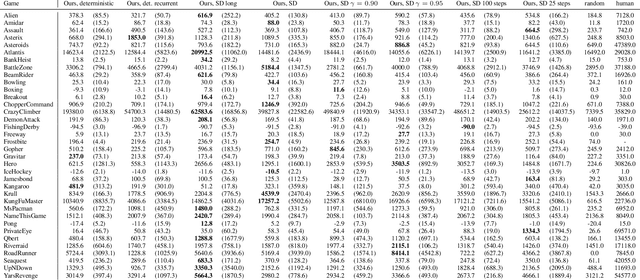
Abstract:Model-free reinforcement learning (RL) can be used to learn effective policies for complex tasks, such as Atari games, even from image observations. However, this typically requires very large amounts of interaction -- substantially more, in fact, than a human would need to learn the same games. How can people learn so quickly? Part of the answer may be that people can learn how the game works and predict which actions will lead to desirable outcomes. In this paper, we explore how video prediction models can similarly enable agents to solve Atari games with orders of magnitude fewer interactions than model-free methods. We describe Simulated Policy Learning (SimPLe), a complete model-based deep RL algorithm based on video prediction models and present a comparison of several model architectures, including a novel architecture that yields the best results in our setting. Our experiments evaluate SimPLe on a range of Atari games and achieve competitive results with only 100K interactions between the agent and the environment (400K frames), which corresponds to about two hours of real-time play.
Area Attention
Oct 30, 2018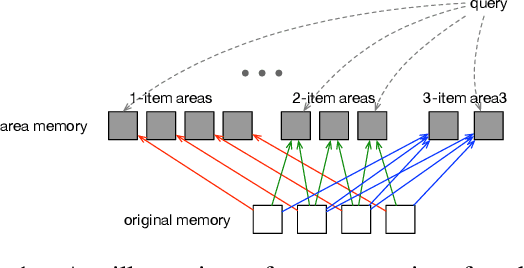

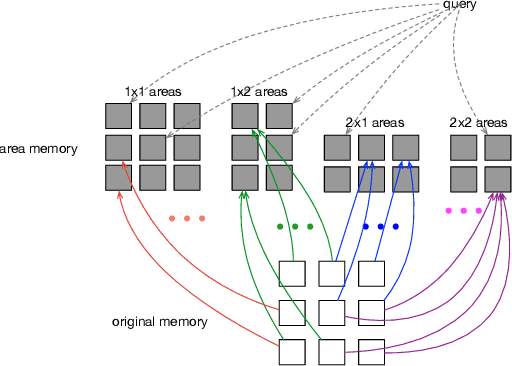

Abstract:Existing attention mechanisms, are mostly item-based in that a model is designed to attend to a single item in a collection of items (the memory). Intuitively, an area in the memory that may contain multiple items can be worth attending to as a whole. We propose area attention: a way to attend to an area of the memory, where each area contains a group of items that are either spatially adjacent when the memory has a 2-dimensional structure, such as images, or temporally adjacent for 1-dimensional memory, such as natural language sentences. Importantly, the size of an area, i.e., the number of items in an area, can vary depending on the learned coherence of the adjacent items. By giving the model the option to attend to an area of items, instead of only a single item, we hope attention mechanisms can better capture the nature of the task. Area attention can work along multi-head attention for attending to multiple areas in the memory. We evaluate area attention on two tasks: neural machine translation and image captioning, and improve upon strong (state-of-the-art) baselines in both cases. These improvements are obtainable with a basic form of area attention that is parameter free. In addition to proposing the novel concept of area attention, we contribute an efficient way for computing it by leveraging the technique of summed area tables.
Generating Wikipedia by Summarizing Long Sequences
Jan 30, 2018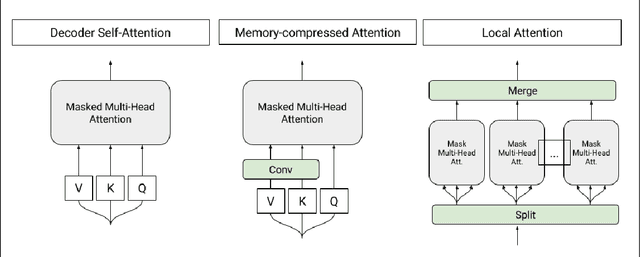

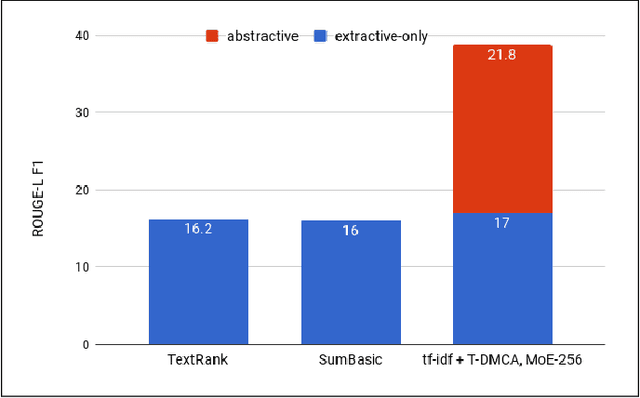

Abstract:We show that generating English Wikipedia articles can be approached as a multi- document summarization of source documents. We use extractive summarization to coarsely identify salient information and a neural abstractive model to generate the article. For the abstractive model, we introduce a decoder-only architecture that can scalably attend to very long sequences, much longer than typical encoder- decoder architectures used in sequence transduction. We show that this model can generate fluent, coherent multi-sentence paragraphs and even whole Wikipedia articles. When given reference documents, we show it can extract relevant factual information as reflected in perplexity, ROUGE scores and human evaluations.
 Add to Chrome
Add to Chrome Add to Firefox
Add to Firefox Add to Edge
Add to Edge